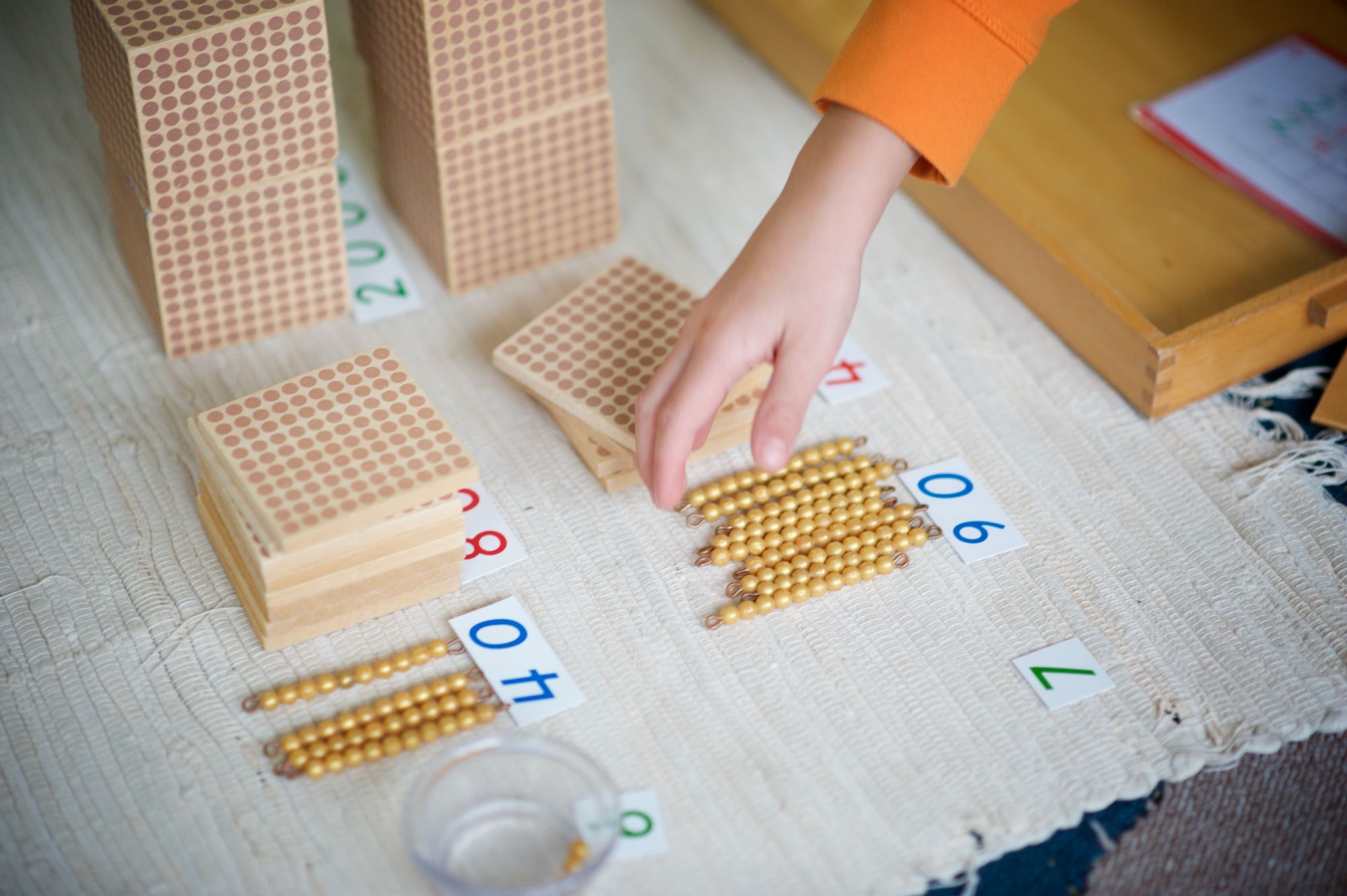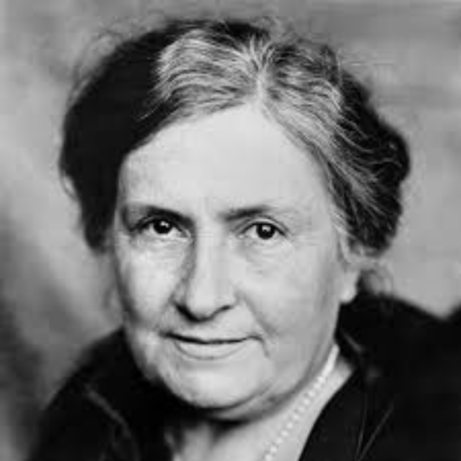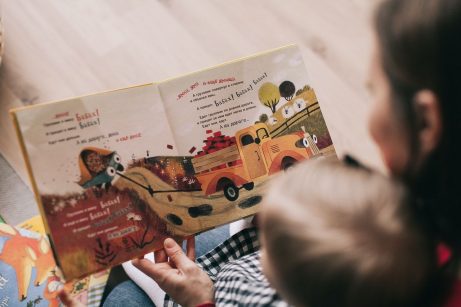Easy as One, Two, Three

On the development of foundational mathematical skills and concepts, why the mainstream notion of math education fails most students, and what can we do about it as parents and educators.
Amongst the many radical things we believe in Montessori, one of the most eyebrow-raising ones is this: there is no such thing as being bad at mathematics, or hating math. There is, unfortunately, a very real concept of being bad at standard mathematical instruction and hating math class – as I am sure that many of you reading this can attest. However, no matter our relationship with the school subject, mathematics and mathematical thinking is something we all use on a daily basis, as natural to us as breathing.
Whether it’s because of a quirk of human nature, or an underlying characteristic of our world, the fact is that people interact with their environment in a constantly, profoundly mathematical way. Dr. Montessori was, in her study of mathematical literacy, influenced and inspired by the work of the mathematician, Blaise Pascal, who stated that the human mind had a predisposition towards exactness, order and precision: in other words, that it had innate mathematical characteristics. Pushing his ideas further, Dr. Montessori established that the mathematical mind is one of the fundamental Human Tendencies that shape our entire way of thinking and being.
When you imagine how we use mathematics in our daily life, you may imagine counting your change at the store or checking the timetable to see how many minutes until the next train; in other words, you think of carrying out algebraic operations. It goes deeper, though. When you’re backing your car into an empty parking spot, cutting an apple into halves to share between your children or pouring a cup of water, you are constantly taking in and manipulating complex data points; you may not be assigning them numerical values but you are calculating – doing math – all the same.
As natural as breathing, we rarely even consciously recognize we are carrying out these tasks, but a child must learn them through painstakingly repetitive hands-on experience. A young toddler doesn’t just know that the entire pitcher of water will not fit into their cup, or that two halves of an apple equal one whole one. They have a mind ready to learn, though, primed and keen to explore. If given sufficient opportunity to see and learn, inevitably, their minds will shape themselves around the foundational concepts of mathematics: relationships of degree, order and sequencing, exchange and equivalence, and so on. Soon they learn the concept of named assigned values – numbers – and later, that they can be considered independently of a physical entity. Much later they will learn perform the most marvelous, magical things with numbers alone.
The Way We Teach Math
In Montessori, we always strive to guide the child’s learning step by step: “isolating difficulty”, working on one concept at a time, to build structured knowledge on firm foundations. The concepts of value, lesser and greater all organized into a sequence is deceptively simple in that we can barely imagine ever not understanding it, and therefore usually have little understanding or empathy for how the child acquires them. What we can do is make sure the child has ample opportunity to really experience the concepts through her own activity, repeating and exploring until she herself knows she’s ready for more. This work starts, for us, as soon as she enters the classroom; but really, for her, the preparation started all the way back in infancy, most of it indirect (the Montessori toddler environment, especially, offers lots and lots of it as well).
In the Primary classroom, children work with the sensorial materials, particularly the pink tower, brown stair and the red rods, with their painstakingly exact decimal-based gradation. They manipulate various sets and objects that were carefully designed to showcase and demonstrate exact, clear, easy-to-see mathematical relationships. Only once they understand the concept of ordering value do we bring numbers as a name for what they already use and recognize.
Once we have numbers, the children practice (to their own satisfaction) assigning these numbers to sets of objects (with the spindle box and others). Forming the numbers by writing is practiced separately because the fine motor control needed is its own difficulty; when the child only needs to mark numbers, she can use tiles and cards or pieces of wood with the number printed on them. Once she masters the concept of assigning values she can start with brilliant new things, like building higher and higher numbers through their physical representations (the golden bead material), or exchanging them, understanding the number families and the equivalences between them: that ten units make one ten. She can see how this is and how it works – literally; she can see that this is a logical way in which the world fits together. All this and much more (we haven’t even touched on the topic of geometry!) takes place before the child ever enters the Elementary classroom, and all of it she finds out from her own work, with the air of an explorer making a marvelous discovery.
Meanwhile, in traditional education, children are told they will start with the numbers: here is the one-two-three. They are asked to memorize, name, represent and manipulate them all at once, perhaps with some physical representation but mostly abstractly, with a pen and paper. They are given the name first, without a clear lived experience of what it means. And things get worse from there – now this here is addition, subtraction, multiplication, division, sit down, write it down, how are you not getting it? If at any point the child is lost, there is no going back; they will endlessly play catch up. Many children learn, along with their numbers, that they are “bad at them”, that some people are just “not into math”, that it is “not their thing”.
Contrast this to the Montessori idea of Math when children carry out activities and manipulations that feel natural – because they are. The teacher doesn’t correct the child’s mistakes because the material itself makes any mistake apparent, allowing the child to fix it as soon as she notices it. The purpose of our materials isn’t to alter the child’s way of thinking but to give clear, strong and exact impressions of mathematical concepts so that she can grasp them quickly and easily, and so she does – knowing that it is because her mind is quick and strong, that she is good at math – because we all are, when we get the opportunity to show it.

Explore the fundamentals of Montessori parenting with this free video by Sylvia Arotin, offering insights and strategies to empower and educate your child.
So What Can We Do?
Option number one: get trained as a Montessori teacher, learn the curriculum, and offer it to as many children as you can. Option number two: send your child to a Montessori school and ask their teacher for more information; one of the side effects of the training is that we just love talking about it, after all.
Option number three, in case one and two are not possible: honor the way the child in your care learns. Let them explore and experiment, get their hands dirty, literally and figuratively: always give the hands lots to do. Offer lots of opportunities for Practical Life, so that your child feels confident and independent in interacting with their environment, and so that they experience rich and varied ways of manipulating it.
Especially in early childhood, make sure your child’s space is very ordered, logically organized and sequenced, and show your child how to maintain this order. “Creative chaos” may be a legitimate environment for an adult, but a young child needs external order to rely on, so that they can work on ordering their mind, their impressions and experiences.
Let your child move. The whole body needs to process information about the world in order for the mind to form itself, and the mathematical portion of the mind is no exception.
When it comes to math skills themselves, don’t push your child to skip ahead. Young children may “know their numbers” and recite them with ease, but this is not a sign we should break out the math textbook – after all, is “counting up to ten” really any different than knowing the words to Wheels on the Bus if it doesn’t carry deeper meaning?
That said, absolutely nothing against singing Wheels on the Bus. Rhythmical language and music are a demonstration of a very particular type of mathematical patterning, and exposure to music also plays a role in the development of the mathematical mind. So sing on!
But instead of encouraging impressive sounding number-related “tricks”, let your child first work on comparing, matching and sequencing: “which stick is longer? Let’s put the biggest rock on this side, which one is the next bigger?”. There are many commercially available toys that encourage sequencing (such as stacking rings decreasing in size) – ideally, look for those made in decimal base and with some measure of control of error. Others can be made or found around us. Look for simplicity and, when possible, exactness, over decorations or many bells and whistles. Remember about isolation of difficulty and find activities that focus on one concept rather than overwhelming multifunctional “activity centers” and similar.
The concept of counting and numbers can be introduced very early on through books, songs and finger plays, especially if your child is interested in it; but before they start grasping the difference between values (are there two dumplings or three dumplings on my plate?) it is fairly unnecessary to count up to higher numbers. Once that happens, however, counting quantities becomes a lot of fun, so go ahead and together with your child, count the steps to your apartment, the balls in the toy box, or passing cars.
Whenever your child has any difficulty in their formal math learning, look for concrete, hands-on representations of whatever is troubling them so that they can explore and practice it in their own time. And for all that is holy avoid the narrative of “being bad at math”, whether to label them with it or yourself. We owe it to our children to let all of them discover and enjoy the beauty and wonder of the mathematical world we share.
Montessori Beginnings
YOUR ULTIMATE
MONTESSORI PARENTING COURSE
FOR ZERO TO THREE
Gain clarity and confidence in your parenting to raise a resilient, independent and joyful child.


